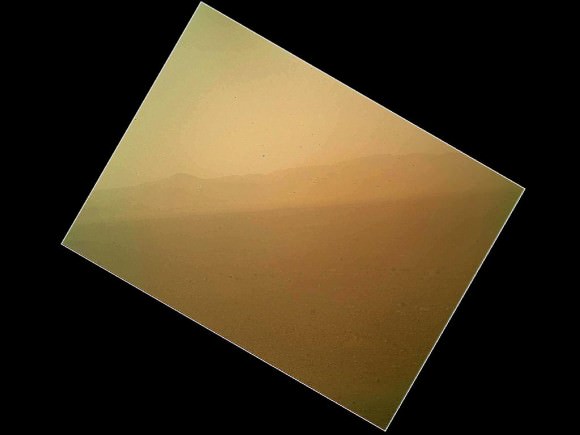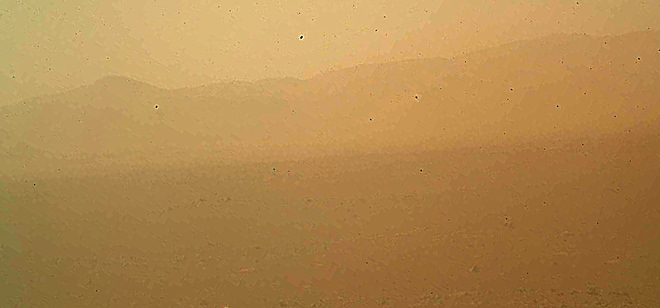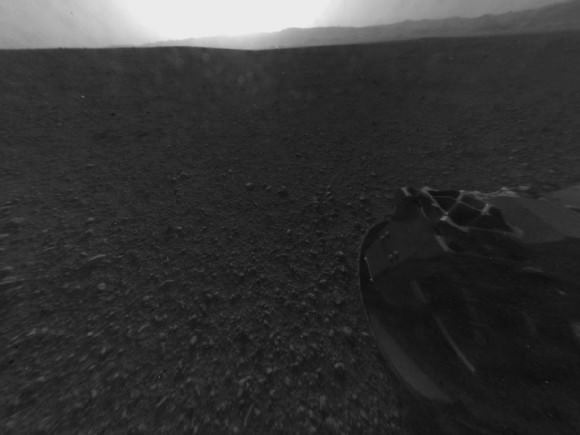Image caption: This murky view from Curiosity shows the martian landscape looking north to the rim from inside the Gale Crater landing site and is her first color image beamed back to Earth. It’s murky because the dust cover is still attached. See full MAHLI image below. Also see below full res Hazcam image of crater rim. Credit: NASA/JPL-Caltech/Malin Space Science Systems
NASA’s Curiosity Mars rover has beamed back her first color view since touchdown, showing a view of the alien landscape pointing northward towards the eroded rim of Gale crater.
The picture was snapped by the rovers Mars Hand Lens Imager (MAHLI) camera on the afternoon of the first day after the pinpoint landing – signified as Sol 1 on Aug. 6, 2012.
The MAHLI image looks murky because the protective dust cover is still in place and is coated with a film of martian dust sprayed up by the descent retrorockets during the terminal phase of the hair-raising landing on Aug 5/6.
The camera’s dust cover is intentionally transparent so that initial images can still be snapped through the cover before it’s popped off in about a week.
MAHLI is located on the turret at the end of the rover’s 8 foot long robot arm which has been stowed in place on the front left side of Curiosity since long before the Nov. 26 liftoff from Cape Canaveral, Florida.
In the stowed position, MAHLI is rotated about 30 degrees as seen in the image below. The top image has been rotated to correct for the tilt and shows the sky “up” as Curiosity is actually sitting on the Martian surface.

Image caption: This full frame view from Curiosity shows the martian landscape looking north to the rim from inside the Gale Crater landing site and is her first color image beamed back to Earth. It’s murky because the dust cover is still attached. The image is from the MAHLI camera on the robot arm and currently in the stowed position. It has been rotated 30 degress. Credit: NASA/JPL-Caltech/Malin Space Science Systems
During her 2 year prime mission, Curiosity’s goal is to determine if Mars was ever capable of supporting microbial life, past or present and to search for the signs of life in the form of organic molecules with a payload of 10 science instruments weighing 15 times more than any prior roving vehicle.
Curiosity is the 3rd generation of NASA rover’s delivered to the Red Planet
Image Caption: Looking Back at the Crater Rim – This is the full-resolution version of one of the first images taken by a rear Hazard-Avoidance camera on NASA’s Curiosity rover, which landed on Mars the evening of Aug. 5 PDT (morning of Aug. 6 EDT). The image was originally taken through the “fisheye” wide-angle lens, but has been “linearized” so that the horizon looks flat rather than curved. The image has also been cropped. A Hazard-avoidance camera on the rear-left side of Curiosity obtained this image. Part of the rim of Gale Crater, which is a feature the size of Connecticut and Rhode Island combined, stretches from the top middle to the top right of the image. One of the rover’s 20 inch wide wheels can be seen at bottom right. Image credit: NASA/JPL-Caltech



NASA are just teasing us now! I say, remove the damn cover! 😛
It is the secret, undercover, part of the mission. 😛
Starting with a trickle… the data will soon come in torrents. When that happens I will finally be able to release my grip on the edge of my chair…. The dust covers make sense but I am surprised NASA did not include a method for clearing or cleaning camera lens’ – a jet of compressed air?
I thought that too, but maybe it;s better to start with a clean lens and have a dust cover on for the time it will be more likely to be covered (landing). Then any cleaning methods they have will be starting with a fresh lens (kind of like how its easier to keep a room clean than to clean it after it gets dirty).
Anyway just speculation because I don’t know what if any methods they have to clean the lens. Maybe they can’t 🙁
Yeah… both Spirit and Opportunity have/had some lens clarity degradation. In Opportunity’s images, the Navigation cameras have suffered the worst of it. Closer to the ground?
In the press conference yesterday they said that they’ve found that dust comes and goes on the Spirit and Opportunity camera lenses with changes in weather and electrostatic pressure and do not tend to accumulate. They believe that the location of the main camera on the mast will reduce exposure to dust and there will not be a significant problem once the dust from the landing is removed with the dust covers.
I prefer to take a ‘wait and see’ position. I have a feeling that in the next couple years we’ll be revisiting this topic!
‘Reminds me of Wisconsin’s ozone pollution map most days: http://airquality.weather.gov/sectors/wisconsin.php
I found more images here:
http://www.nasa.gov/mission_pages/msl/multimedia/gallery-indexEvents.html
Including the sky crane and the back shell from Mars orbit.
Found it:
Under multi-media you can get the RAW incoming images as they come in.
http://mars.nasa.gov/msl/
And here the published images:
http://mars.jpl.nasa.gov/msl/multimedia/images/
Just curious to know, how are the dust covers to be removed?
Many thanks for that link.